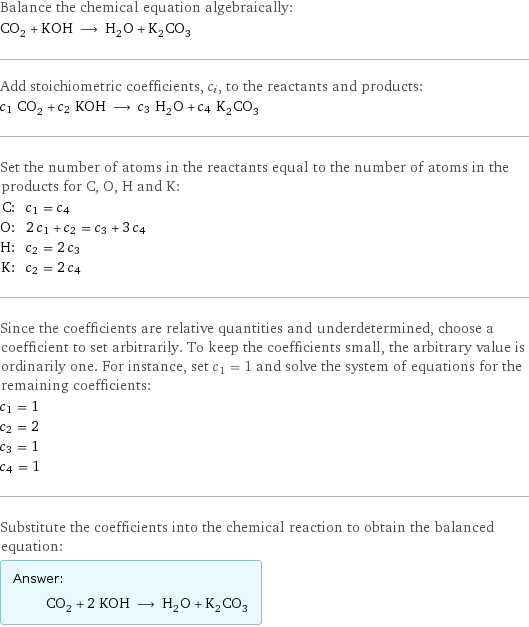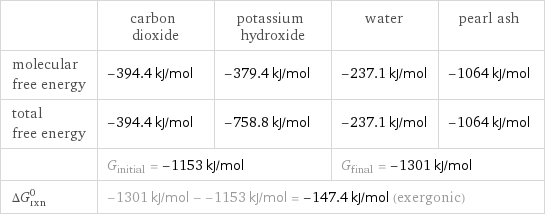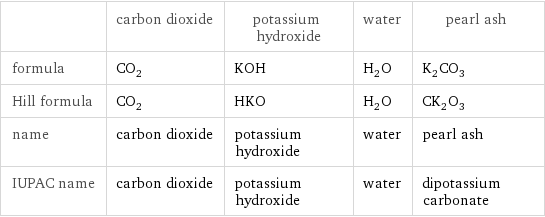Input interpretation

CO_2 (carbon dioxide) + KOH (potassium hydroxide) ⟶ H_2O (water) + K_2CO_3 (pearl ash)
Balanced equation

Balance the chemical equation algebraically: CO_2 + KOH ⟶ H_2O + K_2CO_3 Add stoichiometric coefficients, c_i, to the reactants and products: c_1 CO_2 + c_2 KOH ⟶ c_3 H_2O + c_4 K_2CO_3 Set the number of atoms in the reactants equal to the number of atoms in the products for C, O, H and K: C: | c_1 = c_4 O: | 2 c_1 + c_2 = c_3 + 3 c_4 H: | c_2 = 2 c_3 K: | c_2 = 2 c_4 Since the coefficients are relative quantities and underdetermined, choose a coefficient to set arbitrarily. To keep the coefficients small, the arbitrary value is ordinarily one. For instance, set c_1 = 1 and solve the system of equations for the remaining coefficients: c_1 = 1 c_2 = 2 c_3 = 1 c_4 = 1 Substitute the coefficients into the chemical reaction to obtain the balanced equation: Answer: | | CO_2 + 2 KOH ⟶ H_2O + K_2CO_3
Structures

+ ⟶ +
Names

carbon dioxide + potassium hydroxide ⟶ water + pearl ash
Reaction thermodynamics
Enthalpy

| carbon dioxide | potassium hydroxide | water | pearl ash molecular enthalpy | -393.5 kJ/mol | -424.6 kJ/mol | -285.8 kJ/mol | -1151 kJ/mol total enthalpy | -393.5 kJ/mol | -849.2 kJ/mol | -285.8 kJ/mol | -1151 kJ/mol | H_initial = -1243 kJ/mol | | H_final = -1437 kJ/mol | ΔH_rxn^0 | -1437 kJ/mol - -1243 kJ/mol = -194.1 kJ/mol (exothermic) | | |
Gibbs free energy

| carbon dioxide | potassium hydroxide | water | pearl ash molecular free energy | -394.4 kJ/mol | -379.4 kJ/mol | -237.1 kJ/mol | -1064 kJ/mol total free energy | -394.4 kJ/mol | -758.8 kJ/mol | -237.1 kJ/mol | -1064 kJ/mol | G_initial = -1153 kJ/mol | | G_final = -1301 kJ/mol | ΔG_rxn^0 | -1301 kJ/mol - -1153 kJ/mol = -147.4 kJ/mol (exergonic) | | |
Equilibrium constant
![Construct the equilibrium constant, K, expression for: CO_2 + KOH ⟶ H_2O + K_2CO_3 Plan: • Balance the chemical equation. • Determine the stoichiometric numbers. • Assemble the activity expression for each chemical species. • Use the activity expressions to build the equilibrium constant expression. Write the balanced chemical equation: CO_2 + 2 KOH ⟶ H_2O + K_2CO_3 Assign stoichiometric numbers, ν_i, using the stoichiometric coefficients, c_i, from the balanced chemical equation in the following manner: ν_i = -c_i for reactants and ν_i = c_i for products: chemical species | c_i | ν_i CO_2 | 1 | -1 KOH | 2 | -2 H_2O | 1 | 1 K_2CO_3 | 1 | 1 Assemble the activity expressions accounting for the state of matter and ν_i: chemical species | c_i | ν_i | activity expression CO_2 | 1 | -1 | ([CO2])^(-1) KOH | 2 | -2 | ([KOH])^(-2) H_2O | 1 | 1 | [H2O] K_2CO_3 | 1 | 1 | [K2CO3] The equilibrium constant symbol in the concentration basis is: K_c Mulitply the activity expressions to arrive at the K_c expression: Answer: | | K_c = ([CO2])^(-1) ([KOH])^(-2) [H2O] [K2CO3] = ([H2O] [K2CO3])/([CO2] ([KOH])^2)](../image_source/060e1b05a9bf2bafd2d5502b459a607b.png)
Construct the equilibrium constant, K, expression for: CO_2 + KOH ⟶ H_2O + K_2CO_3 Plan: • Balance the chemical equation. • Determine the stoichiometric numbers. • Assemble the activity expression for each chemical species. • Use the activity expressions to build the equilibrium constant expression. Write the balanced chemical equation: CO_2 + 2 KOH ⟶ H_2O + K_2CO_3 Assign stoichiometric numbers, ν_i, using the stoichiometric coefficients, c_i, from the balanced chemical equation in the following manner: ν_i = -c_i for reactants and ν_i = c_i for products: chemical species | c_i | ν_i CO_2 | 1 | -1 KOH | 2 | -2 H_2O | 1 | 1 K_2CO_3 | 1 | 1 Assemble the activity expressions accounting for the state of matter and ν_i: chemical species | c_i | ν_i | activity expression CO_2 | 1 | -1 | ([CO2])^(-1) KOH | 2 | -2 | ([KOH])^(-2) H_2O | 1 | 1 | [H2O] K_2CO_3 | 1 | 1 | [K2CO3] The equilibrium constant symbol in the concentration basis is: K_c Mulitply the activity expressions to arrive at the K_c expression: Answer: | | K_c = ([CO2])^(-1) ([KOH])^(-2) [H2O] [K2CO3] = ([H2O] [K2CO3])/([CO2] ([KOH])^2)
Rate of reaction
![Construct the rate of reaction expression for: CO_2 + KOH ⟶ H_2O + K_2CO_3 Plan: • Balance the chemical equation. • Determine the stoichiometric numbers. • Assemble the rate term for each chemical species. • Write the rate of reaction expression. Write the balanced chemical equation: CO_2 + 2 KOH ⟶ H_2O + K_2CO_3 Assign stoichiometric numbers, ν_i, using the stoichiometric coefficients, c_i, from the balanced chemical equation in the following manner: ν_i = -c_i for reactants and ν_i = c_i for products: chemical species | c_i | ν_i CO_2 | 1 | -1 KOH | 2 | -2 H_2O | 1 | 1 K_2CO_3 | 1 | 1 The rate term for each chemical species, B_i, is 1/ν_i(Δ[B_i])/(Δt) where [B_i] is the amount concentration and t is time: chemical species | c_i | ν_i | rate term CO_2 | 1 | -1 | -(Δ[CO2])/(Δt) KOH | 2 | -2 | -1/2 (Δ[KOH])/(Δt) H_2O | 1 | 1 | (Δ[H2O])/(Δt) K_2CO_3 | 1 | 1 | (Δ[K2CO3])/(Δt) (for infinitesimal rate of change, replace Δ with d) Set the rate terms equal to each other to arrive at the rate expression: Answer: | | rate = -(Δ[CO2])/(Δt) = -1/2 (Δ[KOH])/(Δt) = (Δ[H2O])/(Δt) = (Δ[K2CO3])/(Δt) (assuming constant volume and no accumulation of intermediates or side products)](../image_source/3e8172f5f5b93401b1246101da9fde95.png)
Construct the rate of reaction expression for: CO_2 + KOH ⟶ H_2O + K_2CO_3 Plan: • Balance the chemical equation. • Determine the stoichiometric numbers. • Assemble the rate term for each chemical species. • Write the rate of reaction expression. Write the balanced chemical equation: CO_2 + 2 KOH ⟶ H_2O + K_2CO_3 Assign stoichiometric numbers, ν_i, using the stoichiometric coefficients, c_i, from the balanced chemical equation in the following manner: ν_i = -c_i for reactants and ν_i = c_i for products: chemical species | c_i | ν_i CO_2 | 1 | -1 KOH | 2 | -2 H_2O | 1 | 1 K_2CO_3 | 1 | 1 The rate term for each chemical species, B_i, is 1/ν_i(Δ[B_i])/(Δt) where [B_i] is the amount concentration and t is time: chemical species | c_i | ν_i | rate term CO_2 | 1 | -1 | -(Δ[CO2])/(Δt) KOH | 2 | -2 | -1/2 (Δ[KOH])/(Δt) H_2O | 1 | 1 | (Δ[H2O])/(Δt) K_2CO_3 | 1 | 1 | (Δ[K2CO3])/(Δt) (for infinitesimal rate of change, replace Δ with d) Set the rate terms equal to each other to arrive at the rate expression: Answer: | | rate = -(Δ[CO2])/(Δt) = -1/2 (Δ[KOH])/(Δt) = (Δ[H2O])/(Δt) = (Δ[K2CO3])/(Δt) (assuming constant volume and no accumulation of intermediates or side products)
Chemical names and formulas

| carbon dioxide | potassium hydroxide | water | pearl ash formula | CO_2 | KOH | H_2O | K_2CO_3 Hill formula | CO_2 | HKO | H_2O | CK_2O_3 name | carbon dioxide | potassium hydroxide | water | pearl ash IUPAC name | carbon dioxide | potassium hydroxide | water | dipotassium carbonate